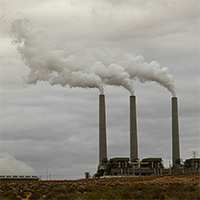
Julia Pyper, E&E reporter
Published: Monday, November 5, 2013
Targets set in China's latest five-year plan aimed at reducing harmful air pollution from the burning of fossil fuels will result in unintended reductions in carbon dioxide emissions that exceed the country's near-term CO2 reduction goals, according to a new study by the Massachusetts Institute of Technology.
China's rapid economic development has led to a spike in pollution from power plants and the industrial sector. To address pollutants that cause acid rain and smog, the government of China established regulations under the 12th five-year plan to reduce emissions of sulfur dioxide (SO2) by 8 percent and nitrogen oxides (NOx) by 10 percent below 2010 levels by 2015.
The plan also calls for a 17 percent reduction in carbon dioxide intensity from 2010 levels.
In a study published this week in the journal Global Environmental Change, MIT researchers found that China's SO2 and NOx regulations alone could reduce carbon dioxide intensity by 20 percent, surpassing its official near-term target.
"It is clear that the unintended benefits of the regulations are substantial and would allow the government to improve air quality, while also cutting the most potent greenhouse gas. We have also learned that carbon emissions may not rise as high as some forecasts suggest, if concerns about conventional pollutants lead to air-pollution reduction policies," said Kyung-Min Nam, lead author of the study and a postdoctoral associate with the MIT Joint Program on the Science and Policy of Global Change.
Carbon dioxide and conventional air pollutants, like SO2 and NOx, come from the same sources, most often the combustion of fossil fuels. Switching from coal to natural gas or reducing energy use in response to air pollution constraints, therefore, will also reduce carbon dioxide emissions.
It will reduce costs, too. MIT researchers estimate that China's SO2 and NOx regulations will produce $3 billion in reduced compliance costs with carbon dioxide intensity targets.
"Considering that the current CO2 target can be attained by the secondary benefits of the SO2 and NOx regulations, policymakers would do well to coordinate the regulatory efforts," said Valerie Karplus, a co-author of the study and the director of the MIT Joint Program's China Energy and Climate Project, in a statement. "Currently, they have room to adopt more ambitious CO2 reduction policies, but the impact will hinge on effective implementation."
The study finds that China could meet its near-term carbon and pollution goals while still expanding the use of coal. However, this path will have a lock-in effect that makes it more expensive to cut down emissions in future. China can achieve cost savings for industries by requiring earlier action and investment in long-term emissions targets, according to the authors.
"China's local air pollution is extremely serious, and the cost of not acting is too big to ignore," Nam added.
In most of China's major cities, particulate matter concentration levels exceed the World Health Organization's guideline levels by a huge margin, he said. Many studies estimate that health damage from the excess pollution in China is substantial, reaching between 4 and 7 percent of gross domestic product.
"So while reducing pollution in China may require non-trivial compliance costs, it will also increase the welfare of local citizens substantially," Nam said.

